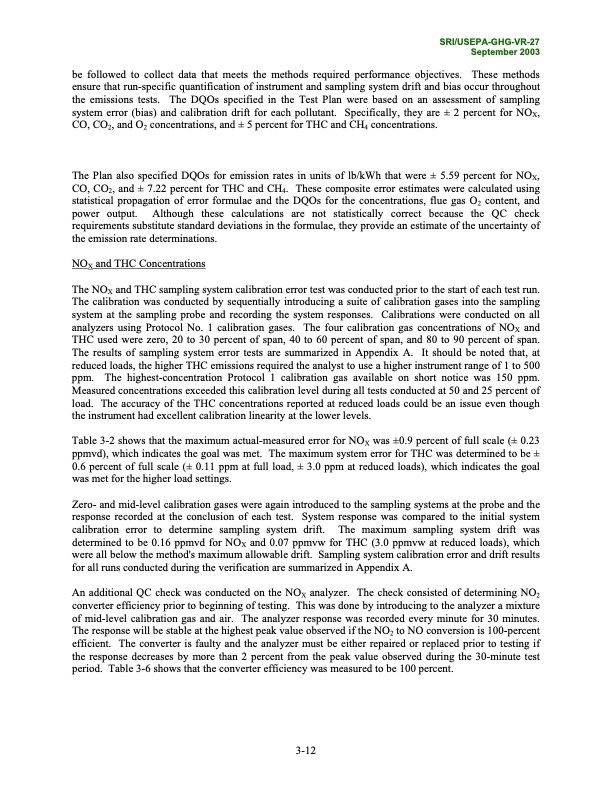
PDF Publication Title:
Text from PDF Page: 064
SRI/USEPA-GHG-VR-27 September 2003 be followed to collect data that meets the methods required performance objectives. These methods ensure that run-specific quantification of instrument and sampling system drift and bias occur throughout the emissions tests. The DQOs specified in the Test Plan were based on an assessment of sampling system error (bias) and calibration drift for each pollutant. Specifically, they are ± 2 percent for NOX, CO, CO2, and O2 concentrations, and ± 5 percent for THC and CH4 concentrations. The Plan also specified DQOs for emission rates in units of lb/kWh that were ± 5.59 percent for NOX, CO, CO2, and ± 7.22 percent for THC and CH4. These composite error estimates were calculated using statistical propagation of error formulae and the DQOs for the concentrations, flue gas O2 content, and power output. Although these calculations are not statistically correct because the QC check requirements substitute standard deviations in the formulae, they provide an estimate of the uncertainty of the emission rate determinations. NOX and THC Concentrations The NOX and THC sampling system calibration error test was conducted prior to the start of each test run. The calibration was conducted by sequentially introducing a suite of calibration gases into the sampling system at the sampling probe and recording the system responses. Calibrations were conducted on all analyzers using Protocol No. 1 calibration gases. The four calibration gas concentrations of NOX and THC used were zero, 20 to 30 percent of span, 40 to 60 percent of span, and 80 to 90 percent of span. The results of sampling system error tests are summarized in Appendix A. It should be noted that, at reduced loads, the higher THC emissions required the analyst to use a higher instrument range of 1 to 500 ppm. The highest-concentration Protocol 1 calibration gas available on short notice was 150 ppm. Measured concentrations exceeded this calibration level during all tests conducted at 50 and 25 percent of load. The accuracy of the THC concentrations reported at reduced loads could be an issue even though the instrument had excellent calibration linearity at the lower levels. Table 3-2 shows that the maximum actual-measured error for NOX was ±0.9 percent of full scale (± 0.23 ppmvd), which indicates the goal was met. The maximum system error for THC was determined to be ± 0.6 percent of full scale (± 0.11 ppm at full load, ± 3.0 ppm at reduced loads), which indicates the goal was met for the higher load settings. Zero- and mid-level calibration gases were again introduced to the sampling systems at the probe and the response recorded at the conclusion of each test. System response was compared to the initial system calibration error to determine sampling system drift. The maximum sampling system drift was determined to be 0.16 ppmvd for NOX and 0.07 ppmvw for THC (3.0 ppmvw at reduced loads), which were all below the method's maximum allowable drift. Sampling system calibration error and drift results for all runs conducted during the verification are summarized in Appendix A. An additional QC check was conducted on the NOX analyzer. The check consisted of determining NO2 converter efficiency prior to beginning of testing. This was done by introducing to the analyzer a mixture of mid-level calibration gas and air. The analyzer response was recorded every minute for 30 minutes. The response will be stable at the highest peak value observed if the NO2 to NO conversion is 100-percent efficient. The converter is faulty and the analyzer must be either repaired or replaced prior to testing if the response decreases by more than 2 percent from the peak value observed during the 30-minute test period. Table 3-6 shows that the converter efficiency was measured to be 100 percent. 3-12PDF Image | Environmental Technology Verification Report

PDF Search Title:
Environmental Technology Verification ReportOriginal File Name Searched:
Capstone-ETV-Report.pdfDIY PDF Search: Google It | Yahoo | Bing
Capstone Turbine and Microturbine: Capstone microturbines used and new surplus for sale listing More Info
Consulting and Strategy Services: Need help with Capstone Turbine, sizing systems, applications, or renewable energy strategy, we are here to assist More Info
Container Lumber Dry Kiln: Since 1991 developing and innovating dry kilns using standard shipping containers More Info
Supercritical CO2 Lumber Dry Kiln: Compact fast drying in 3 days or less for small amounts of wood and lumber drying More Info
BitCoin Mining: Bitcoin Mining and Cryptocurrency... More Info
Publications: Capstone Turbine publications for microturbine and distributed energy More Info
FileMaker Software for Renewable Energy Developing database software for the renewable energy industry More Info
CO2 Gas to Liquids On-Demand Production Cart Developing a supercritical CO2 to alcohol on-demand production system (via Nafion reverse fuel cell) More Info
Stranded Gas for low cost power Bitcoin Mining Using stranded gas for generators may provide breakthrough low power costs for cryptocurrency miners. More Info
| CONTACT TEL: 608-238-6001 Email: greg@globalmicroturbine.com | RSS | AMP |